Salt Lake County Public Art Collection
Valerie Price, Public Art Manager
Art connects people to a place, a time, a community. Salt Lake County honors this connection and the spirit and values of the people who live and work in our community through the Salt Lake County Art Collection.
Our Fine Art collection is fun and eclectic with an important unifying theme – Utah. Each artist has lived or worked in Utah or is currently working in Utah. Looking at the collection as a whole, it is an excellent representation of traditional and modern art and of life in Salt Lake County.
The County began the Fine Art collection in 1986 to decorate the newly constructed County Government Center. Today we have more than 600 pieces of art, including paintings, photographs, mixed media and sculpture and all the pieces are on display at county facilities, with the majority at the County Government Center. Each year, the Public Art program receives a modest budget to purchase new pieces for the collection.
The pieces shown in this post are the new 2020 acquisitions. While we are still looking for their permanent homes, please enjoy them virtually. For more information on the collection, visit our website.
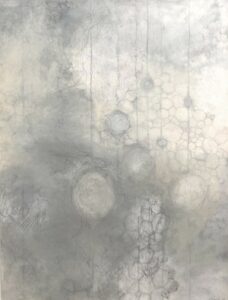 Lydia Gravis
Lydia Gravis
Bounce Back, Sink Down, Float Up, Repeat
Mixed Media on Paper
Lydia Gravis was born in 1981 in Spokane, Washington. She earned her B.A. in painting and drawing from Warren Wilson College in Asheville, N.C. in 2003 and her M.F.A. in visual art from the Art Institute of Boston at Lesley University in 2013. She’s had solo exhibitions at the Northern Arizona University Museum of Art, in Flagstaff, Arizona, Nox Contemporary in Salt Lake City, Utah, and the Argo House, presented by Carper Contemporary Pop-Up Exhibitions in Ogden, Utah. Recent media coverage includes a featured artist profile in the December 2019 edition of 15 Bytes: Utah’s Online Art Magazine, and a 2-page feature about her work in the January 2020 edition of American Art Collector magazine. She’s shown in numerous group and juried exhibitions in the United States and was recently awarded an artist residency at the Fremantle Art Center in Fremantle, Western Australia for Summer 2021. She’s worked as Gallery Director and Curator of the Mary Elizabeth Dee Shaw Gallery within the Department of Visual Art and Design at Weber State University since 2014, and lives and works in Ogden, Utah with her husband and two young children.
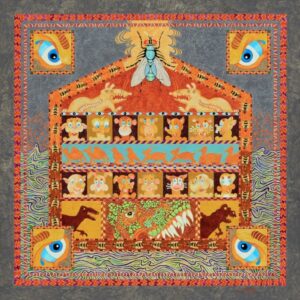 Howard Brough
Howard Brough
ah-prey da dey-looj
Acrylic on Board
Born in the 50’s, Howard Brough grew up in Provo, Utah. In the early 70’s he moved to Salt Lake City to study art at the University of Utah and he was later accepted into an MFA program at a small liberal arts college in the San Francisco Bay Area. In 1977, he completed his art studies in Tuscon, Arizona. After graduation he returned to Salt Lake City and began working for the Salt Lake City Library System managing and curating exhibitions at the main branch art gallery for 30 years. After retirement Brough began creating artwork full time.
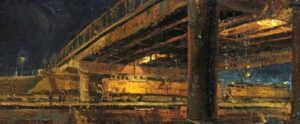
Donald Yatomi
Union Pacific 31
Oil on Canvas
Donald Yatomi is an oil painter living and working in Bend, Oregon, best known for his contemporary urban themes. Born in Okinawa, Japan, Donald has been painting for over 30 years. He graduated from the University of Hawaii with a BFA in Painting, before attending the prestigious Art Center College of Design, where he graduated with a second BFA in Illustration with distinction. Since then, he’s accomplished much in entertainment design, working with companies such as DreamWorks Studios and Sony Interactive Entertainment, as well as painting for art galleries. Donald’s love for contemporary realism and urban themes shows through in his paintings, where he strives to capture the raw beauty of the modern, industrial form. His preferred medium is oil. Donald and his family resided in Utah from 2000 – 2007. Find his works at A Gallery (Salt Lake City, UT) and Peterson Roth Gallery (Bend, OR).
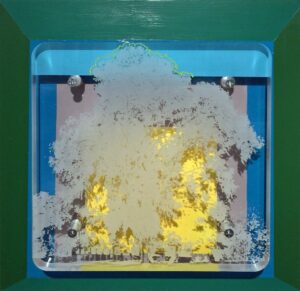 Janell James
Janell James
Apparition
Etching & Acrylic
Utah is my place of birth, residency and continual adventure. I love to hike and run the mountainous trails, smell the minerals of the earth on a rainy day, the decay of leaves from the trees hibernating through winter, and listen to the crunch of the snow as I move along in this nature wonderland. It is the four seasons that I long for as I watch the colors of the trees change from brown to bright yellow and lush green. Traveling and camping with my dogs, we can go off in any four directions in this beautiful state and discover something new. Some terrain feels like we have just left the planet and landed on the moon, other places take us back in time to the days of the Anasazi Indians, and some places are so wild you can hear the coyotes, see the rattlesnakes and watch wild horse.
It is a land full of abstractions and color. My eye has been especially drawn to the way the trees press against the sky. It has always been these shapes that capture my heart making me want to express the way I see the landscape. Seeing nature through this abstracting lens has allowed me many opportunities to explore my vision. As I continually absorb the abstract in nature around me, I am inspired by the many ways in which I am called to create.
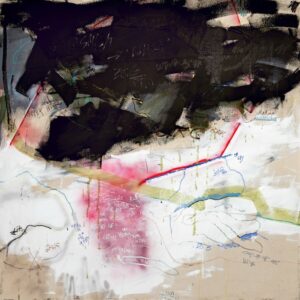 Nolan Flynn
Nolan Flynn
Corrected Landscape
Mixed Media
Born in Kalamazoo, Michigan – a small town with about eighty thousand people – Nolan Flynn was raised by both of his parents. Growing up with two supportive parents, one who was a high school art teacher and another who taught history, Flynn was introduced to art at an early age. Moving forward, he found everything but art difficult and unpleasing, which led him to pursue a degree in art after receiving an art scholarship from Western Michigan University. He studied and worked throughout the program, emphasizing on painting with a focus on formalist studies of portraits and the human form.
After graduating from WMU, Flynn opened his own studio at the Park Trades Center in Kalamazoo, home to over 200 active local artists. It was a great space to nurture new ideas and find his own authorship within his marks and ideas. Flynn strayed from the more anticipated facial facades he had been trained in and entered the wide world of abstraction with a grounded approach to structural elements. This carried on for another four years, until he became bored with the figure and graffiti-like patterning. He then decided he was ready for the next challenge, which led him to graduate school at the University of Utah.
Leaving everything he was working on up to that point, he threw the idea of the human pursuit through figures out the window and focused on the ideas and decisions involved with creating the work. Flynn worked on developing a codified vernacular and highlighting the narrative of the artwork through sketches and nots, interacting and communicating on the canvas.
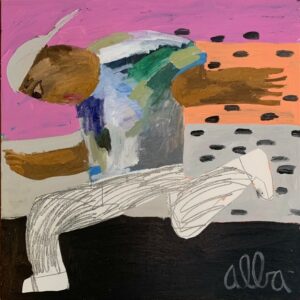 Andrew Alba
Andrew Alba
Running (34-22) 2020
Oil on panel
As a self-taught artist and descendant of Mexican migrant workers, Alba’s large-scale paintings and drawings evoke an emotional response while still maintaining relevant commentary on contemporary politics and society. Alba has exhibited work throughout the Pacific Northwest and Salt Lake City where he currently resides. He recently completed a residency at the Utah Museum of Contemporary Art and now is in residence at Modern West Fine Art with representation there as well.
![]()
Leslie Pippen
“Panopticon” 2015
Mixed Media on Canvas
Leslie D. Pippen is originally from East Texas but has made Salt Lake City his home for over a decade. Of his current medium and process Pippen says:
“Plastic is the material of modern mechanical reproduction and the legacy of human distancing from nature. It is quite possibly the residue of a creature that has outgrown its incubator and exhausted the yolk.
“The paintings are all based on the gesture of swiping with a finger, which has become our common gesture! I’ve reduced the surface to that of a screen!
“The bead has a long, ancient history as currency traded with native people. They were used amongst various tribes, on different continents. Beads were the beginning of self-adornment and beautification! I’ve chosen the pony bead first for these reasons, but as plastic and turned on its side it speaks about capitalism and transparency.”
